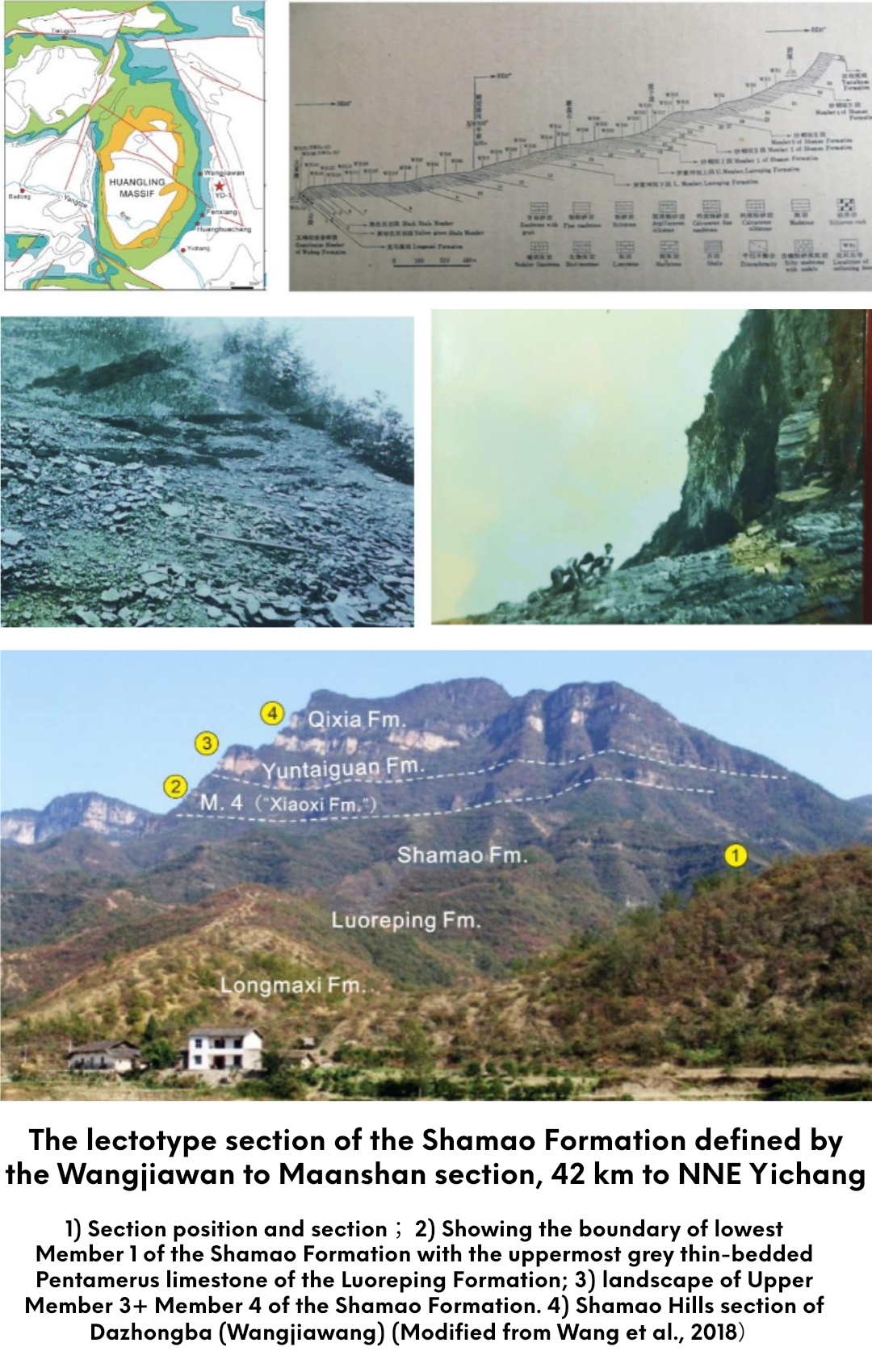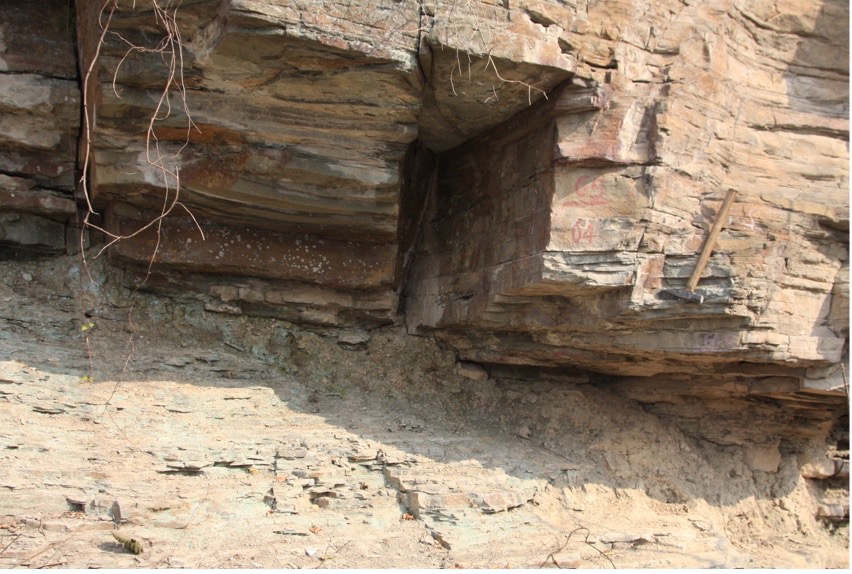Shamao Fm
Type Locality and Naming
It was originally named as Shamaoshan (Hills) System by Xie Jiarong and Zhao Yazen (1925) and subsequently changed as Shamao Gr or Shamao Formation by Yin Zhanxun (1949)/Mu (1962) and Nanjing Institute of Geology and Paleontology (NIGP) (1974), referring to a set of sandwiched shale, sandstone, siltstone and a little limestone lenses overlying conformably on the Luoreping Fm and underlain unconformably by the Middle Devonian Yuntaiguan Fm. Type section is located at the hill, called as Wulongguan with a small temple at the top, NE of Dazhongba (i.e., Luoreiping, or Luoreping), 40 km north of the Yichang City in western Hubei Province. The naming section is not well exposed and neotype is located in Wangjiawan to Maanshan, 3 km of Wanglongting (Figure) (Wang Xiaofeng et al., 1987).
Synonym: (纱帽组) . The Jiulongshan Bed was proposed by Yu Jianzhang and Shu Wenbo (1929). The nominative section is located from Taihongshan to Niuxingzai, west of the Nanzhang County seat in northwestern Hubei, specifically indicating the uppermost sandstone of the Silurian System exposed in the area of Xiangyang, Nanzhang and Jinmen. Yin Zanxun (1949) held that the Jiulongshan Bed should be a synonym of the Shamao Formation. The authors agree with the opinion herein to correlate the Mb.4 of the Shamao Fm with the Xiaoxiyu Fm (=Xiaoxi Fm).
[Figure 1: The lectotype section of the Shamao Formation defined by the Wangjiawan to Maanshan section, 42 km to NNE Yichang]
Lithology and Thickness
It is subdivided into 4 lithological members, excluding the uppermost white thick-bedded quartz sandstone of the original Shamaoshan beds proposed by Xie and Chao (1925), which is referred as the Middle Devonian Yuntaiguan Fm. The scope is same as the Shamao Gr or Formation revised by Yin (1949) and Mu (1962). NIGP, CAS (1974) subdivided the Shamao Group into the Shiwuzi Formation in the lower part and Shamao Formation in the upper part. The former is same as the Lower Shamao Group suggested by Ge and Rong (1979), Rong in Lin et al. (1998), and probably equivalent to the members 1-3 of the Shamao Formation by Wang et al. (1987).
A detailed investigation indicated that 4 lithological members can be recognized in the Wangjiawan-Maanshan Neotype section, showing two gentle slope (Member 1 and 3) and two steep slope (Members 2 and 4) in landform (Figure 2). Member 1 mainly comprises grey-green silty mudstone intercalated with thin-medium bedded pelitic siltstone, 77.4 m thick, containing brachiopods, trilobites and a few graptolites. Member 2 is dominated by yellow-green and greyish-green thin and medium-thick bedded siltstone, fine sandstone intercalated with sandy shale and shale, 118 m thick. Its base is marked by the incoming of 3 beds of purplish-red mudstone and top distinguished from the base of Member 3 by a band of brown ferruginous calcareous sandstone of 0.93 m with conodonts. Wave marks and trace fossils are quite clear on the surface of sandstone. Member 3 is a sequence of yellowish or greyish-green shale, sandy shale with a few bands of argillaceous siltstone, 284 m. Member 4 is grey green with purplish-red medium-thin layer fine-grained quartz sandstone, siltstone, intercalated with thin-bedded sandy shale interlayers, wave marks and trace fossils on the rock surface, 193 m thick.
[Figure 2 the boundary between Member 1 and Member 2 of Shamao Fm at the Wangjiawan-Maanshan section]
Relationships and Distribution
Lower contact
It is conformable contact with the underlying Luoreping Fm. The base of Member 1 is distinguished from the Luoreiping Fm by the disappearance of the thin-bedded limestone with brachiopods Sulcipentamerus and the incoming of yellow –green shale with rare graptolites of Metaclimacograptus undulates (= Climacograptus nebula Mu, 1975; Climacograptus nebula Wang, 1987).
Upper contact
It is unconformably overlain by the Yuntaiguan Fm of the Middle Devonian (Figure3).
[Figure 3 the unconformity between Shamao Fm and the overlying Yuntaiguan Fm of the Middle Devonian at the Wangjiawan-Maanshan section]
Regional extent
It is widely spread in the West Hubei, including Yichang, Zigui, Jinshan, Changyang, Yidu etc. and usually correlate with the Rongxi Fm and Xiushan Fm exposed in west Hunan and north Guizhou.
GeoJSON
Fossils
The fossils of the Shamao Formation is diverse, but not very high in abundance, and characterized by appearance of number of shelly fossils and few graptolites and chitinozoans. The fossils mainly present in the Member 1-3, and rare in the Member 4. The main species of graptolites and chitinozoans in the Member 1 includes Metaclimacograptus undulates (= Climacograptus nebula Mu, 1975; Climacograptus nebula Wang, 1987) usually occurring in the Lower-middle Stimulograptus sedgwiskii Zone (Maletz et al., = 2020) and chitinozoans of Conochitina mallus Zone (Chen et al., 2018), Diversified shelly fossils include Brachiopods of the Nalivikina-Nucleospira assemblage; trilobites Latiproteus latilimebatus, Encrinuroides, Gaotania, Scutellum and corals, crinoid columnal, ostracod, etc. The Member 2 yields graptolites, conodonts, brachiopods, trilobites, chitinozoans, ostracods and trance fossils. Principal graptolites,separately found in the lower and middle parts, include Monograptus cf. drepanoformis, Pristiograptus variabilis, P. regularis, Petalolithus cf. minor etc.. Conodonts originally attributed to the Plerospathodus celloni Zone (Ni et Li in Wang et al., 1987), is now being revised to the Pterospathodus eopennatus Zone by Wang et al. (2010), occur in calcareous sandstone of 0.93 m in the uppermost Member 2 and chitinozoans of Plectochitina pseudoagglutinans Zone(Chen et al., 2018)or Lower Eisenackitina daozhenesis Zone (Li et al., 2021). Main brachiopods are Nucleospira pulchra, Zygospiraella, trilobites Latiproteus latilimebatus and trace fossils. The fossils in the Member 3 is significantly reduced, mainly including brachiopods, Nalivikina elongate, Striispirifer sp., trilobites, Latiproteus latilimebatus, Coronocephalus sp., bivalves, dendroid graptolites and chitinozoans of Eisenackitina dolioliformis and Eisenackitina causiata Zones corresponding to the Upper E. daozhenensis Zone (Li et al., 2021). The fossils in the Member 4 is characterized by appearance of large-scale tubular trace fossils (Palaeophycus sp. Planolites sp.) in the surface of sandstone and chitinozoans of the Conochitina acuminate Zone (Chen et al., 2018) or Angochitina longicollis revised by Li et al. (2021) in the thin-bedded interlayers of sandy shale and mudstone.
Age
Depositional setting
Additional Information


